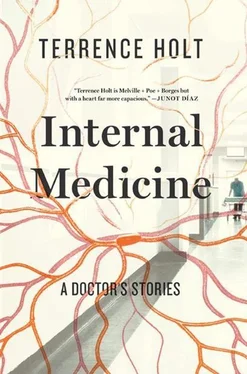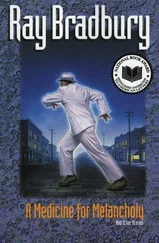Whatever the preacher was saying, he was done. There was a long, dreadful pause, and then the static arrangement of the mourners began to dissolve, currents of dark suits and dresses dispersing among the graves toward the parking lot. I watched a while longer. I had spotted Linda earlier, among the group of mourners just outside the awning. I waited for her to emerge, passing the time observing how the birds receded from the human tide: I thought I could see them watching from the higher branches of the trees, waiting for the last mourners to cede the churchyard back to them.
I could see Linda speaking to the large, balding figure of Charles Turner, the two of them nodding and bobbing back and forth. Then Linda turned and pointed in my direction, Turner looked as well, and the two of them began to make their way from the grave toward me. As they approached, I could see that Linda had worn a navy blue dress, in which she was almost unrecognizable. Turner, too, in a business suit seemed as out of place as a robin in a cage. He carried a parcel, a rectangle done up in brown paper and twine. Linda carried another like it.
“Doc,” Turner said quietly. He extended his free hand, then the one with the parcel, and for a moment neither one of us knew what to do until Linda laughed. Turner shook his head as if shying off flies. He thrust the package at me again: “Sylvie wanted you all to have these.”
I stammered something, looked to Linda for an explanation, but all I got was a shrug. I took the parcel, the hard ridge of the frame under the paper telling me what I had already known.
“Is it one of hers?” I asked, knowing the question was stupid.
Turner nodded. “She thought you should have it.” He looked away for a moment, out over the roof of the church, and cleared his throat. “She painted these after she got sick.”
I stood there, at a loss for words.
“Open it,” Linda said.
It was an oil on canvas, a portrait of an anonymous young woman posed against some indefinite outdoor space, the sky pale blue beyond her head and shoulders, a bright, suffused light filling the frame. She had light brown hair that fell in ringlets around her neck. Her eyes were open wide, her mouth an O of delight as she looked up to her side. Her right hand was lifted as well, index finger extended; a moment ago it had been the perch of the bird that now hovered, wings uplifted at the top of their stroke, the object of her gaze. It was a parakeet, pale blue, almost the same color as the sky, so that it seemed to be fading into the light that lit the woman’s face. Then I noticed the bird had a tiny, distinct golden halo over its head. And that the woman’s head, too, had the faintest suggestion of a halo as well. Linda’s painting could have been its twin, except in hers there was no bird at all, only the same faint glory over the same rapt skyward gaze.
“I can’t take this—” I began.
“She told me to give it to you, Doc. One to Linda and one to you.” He looked at us, his red-rimmed eyes giving us a direct stare, the force of it almost palpable. “I’ve got a thousand others. And if I had a million more it wouldn’t—” He broke off. “I don’t need it.”
“Thank you,” Linda said. She was signaling me with some message I didn’t get. I was stammering, and then the three of us fell silent again. Somewhere the harsh call of a jay refused the silence.
“Thank you,” I said finally. We looked at the paintings a moment longer. The face in each was lovely. I wondered if Mrs. Turner’s face had once been so luminously beautiful, or if, behind her mask, she had felt free to paint something other than she had before.
I would never know.
WHEN I GOT HOME, I left the painting in the garage until after the children were in bed. I brought it in then, and for a long time my wife and I looked at it. “It’s a beautiful painting,” she said.
For a long time afterward, whenever I closed my eyes, I would see that painting shimmer indistinctly in the darkness. When I opened them it still hovered, a vague shape drawing nearer, ghostly, a faint rectangle of light. As it approached it would resolve, and finally reveal that face now hidden in the undying darkness of the grave.
THE HOSPITAL WAS A TERRIFYING PLACE to look at. A fortress of weather-stained limestone, it glowered over the surrounding city from its hilltop, surrounded by oak trees that had been old when Sherman’s forces had marched by. Seen at night during an electrical storm, it completely fulfilled whatever fantasy the words “psychiatric hospital” might conjure. But the ancient oaks, the gray-streaked limestone, and the razor wire were only superficial aspects of a building that had, within its walls, four-hundred-plus patients whose appearance was anything but terrifying. “Sad” was the word that came most often to mind.
On the ward for which I was responsible, there were on most nights three or four dozen women, ranging in age from their late teens to their early sixties, hospitalized for treatment of their substance abuse, depression, mania, suicidality — a profound inability to get along with the rest of the world. Most stayed only a week or two, cycling between the ward and the streets, returning sometimes after as little as six or seven hours outside the walls. On each admission, each patient had a physical exam and medical history taken by the psych intern. On Friday and Saturday nights, my first responsibility as the medical moonlighter on call was to review these new admissions to the acute women’s ward.
I was grateful to have the job. In the final months of my training, anything that eked out the salary I earned as a subspecialty resident was welcome. Here I earned a dollar a minute and went home at midnight. The work wasn’t heavy, consisting primarily of overseeing the intern, and often it was interesting, from a medical perspective. The patients had a startling variety of medical illnesses.
As for their mental illnesses, especially once the acute manifestations had been bottled up, this was generally a drab affair. The patients lacked much in the way of facial expression, their clothing had a similar threadbare quality, and their histories tended, through repetition if nothing else, to have rubbed off all the corners that might once have made them the distinct stories of individuals. After so much cocaine, prostitution, and cutting of wrists, after so many delusional pregnancies and divine possessions, in the strong solvents of alcohol, street life, and psychosis, individuality dissolves.
On my first night I arrived still wearing a necktie. The nurse who met me in the medical unit laughed out loud. “Best take that off, hon,” she said. This struck me as dramatizing, but I complied. And although in certain areas of the hospital (the forensic wing, chiefly) it seemed only a fool would give anyone a handle to grab hold of, among most of the patients one felt not fear so much as a guilty aversion, a continual, if muted, grating on some inner nerve, the emotional equivalent of someone dragging heavy metal furniture across concrete several floors overhead.
Each evening, after letting myself through the two sets of locked doors that sealed off Acute Women’s, I couldn’t get halfway to the nursing station before patients would start to flock around me, all of them talking. Some wanted to tell me about a symptom they were having, or show me some unusual sign. More often it was a plea for discharge (in which decisions, thankfully, I had no say). Sometimes it was to adjudicate disputes with another patient, a nurse, a doctor, a parole board or judge, or some personality I could only hope was imaginary. Occasionally I was met with a flat stare, or accused in ringing tones of terrible crimes. I walked quickly, avoiding eye contact as much as I could.
Читать дальше












